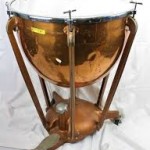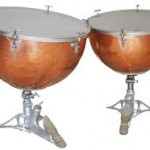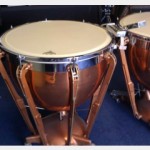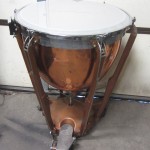Instruments| Ludwig Timpani
I have performed on many makes and models of timpani, but I started out as an eleven-year old aspiring musician on an old pair of Ludwig pedal-tuned timpani. These dated from about the late 1930s, and were the template model for what Ludwig later developed into their Universal model pedal timpani. Unlike the later Universal pedal timpani, there were no wheels on the base; the kettle shape was more akin to the old Leedy champagne-glass type, and the
sizes were 25 inch and 28 inch. The kettles were a bit worn, to say the least and the heads were Ludwig Ensemble heads, and they were not extended collar heads. These drums pre-dated the extended collar option by many years. As I was not old enough to make a mature judgement at the time, I can only say that I was bowled over by these drums – much like one is when one gets his or her first car – and they looked and sounded like gold. Actually, they were kept in pretty good shape (I suspect that they were in storage for several years as the school wasn’t using them when I joined the band). I remember that whoever got them back into shape did a pretty good job as the pitch on both drums was pretty clear. I had a pretty good ear for tone even at the tender age of eleven, and I learned how to tune the timpani with both pedal and t-handle on those drums. Later on in my career – very much later in fact – I played on a similar set of Ludwigs owned by John Svendsen – then the timpanist of the Norwegian Broadcasting Orchestra. They were of the same vintage, but the bowls were in much better condition, and he had had calfskin heads mounted on the instruments. In order to provide access for sponges in case of low humidity – a valid concern on bitter cold winter days – he had small holes cut into the side of the kettle and hygrometers inserted. This worked out quite well, and the sound of those drums with good quality calfskin heads was quite amazing. I played on these drums a few times – once doing the Bach Christmas Oratorio – and was quite thrilled with the sound, in combination with the baroque-style mallets I was using.
Ludwig Symphony Model
After my junior high school years, I moved on to the high school, and there I found a pair of Ludwig Standard Symphony model timpani, also sizes 25 inch and 28 inch. These were somewhat newer than the older timpani that I had started on, and I figure them dating from the early 1950s. The bowls were free of dents and they looked just great. (Author’s note: This was the period when school bands and orchestras generally made do with a pair of timpani in their organizations. Three drums were rare – four drums rarer still. There were exceptions of course, but not in my neck of the woods, The mid to late 1960s saw a change in this as school organizations started to equip themselves with newer equipment, they would add the outside drums.)
These drums were in good shape as I said, and the Standard Symphony model (as it was called then), was developed to look a little like the European type timpani as Ludwig was catering to professional organizations at the time. Like  the Universal timpani, the tuning spider mechanism (as I like to call it) was on the inside of the kettle – the central rod going out the bottom of the kettle and through the top of the base –attached to the actual pedal mechanism concealed in the base. The kettle was not suspended in a ring – that came with the Professional Symphonic Model years later – but had supporting struts attached to the kettle by means of nuts and bolts. They also had t-handles on top of the tension rods, so the drum could be fine-tuned (this was before Ludwig and other companies dispensed with the T-handle altogether. The heads were of the normal non-extended collar type of the day – usually Ludwig heads. On these drums, these were designated the “Ensemble” type . They were, as I said – in much better shape than the old Universals I played on in junior high school, and they sound was bigger – and fuller. I had other experiences with this model later in my career – I started out my tenure with the Albany Symphony Orchestra on a complete set of 1950s Ludwig Symphony timpani – sizes 30”,28”,25” and 23”. The 30 inch was good, as was the 25” and the 23” was acceptable in a pinch. Not so the 28 inch. It was horribly out of round, as if someone had dropped it off a cliff. Most of my work on those drums was done on everything but the 28” if I could help it. During my tenure as adjunct at Joliet Junior College, there was a set of Symphony models of the same vintage, but much better cared for. The heads on them were a mix of Remo clear and hazy. At least they were in round, but the sound of them was much smaller and less fuller than I remembered from even my Albany days, and while they were most usable, I as glad when we replaced them with a set of Yamaha 6200s. The Standard Symphony timpani had been the mainstay of many major orchestras in the 1950s and early 1960s, and at the time they served them well. I tip my hat to the likes of my predecessor at the Oslo Philharmonic who used them very well, as well as to the late Ed Metzger and Donald Koss of the Chicago Symphony, who made them sound great!
the Universal timpani, the tuning spider mechanism (as I like to call it) was on the inside of the kettle – the central rod going out the bottom of the kettle and through the top of the base –attached to the actual pedal mechanism concealed in the base. The kettle was not suspended in a ring – that came with the Professional Symphonic Model years later – but had supporting struts attached to the kettle by means of nuts and bolts. They also had t-handles on top of the tension rods, so the drum could be fine-tuned (this was before Ludwig and other companies dispensed with the T-handle altogether. The heads were of the normal non-extended collar type of the day – usually Ludwig heads. On these drums, these were designated the “Ensemble” type . They were, as I said – in much better shape than the old Universals I played on in junior high school, and they sound was bigger – and fuller. I had other experiences with this model later in my career – I started out my tenure with the Albany Symphony Orchestra on a complete set of 1950s Ludwig Symphony timpani – sizes 30”,28”,25” and 23”. The 30 inch was good, as was the 25” and the 23” was acceptable in a pinch. Not so the 28 inch. It was horribly out of round, as if someone had dropped it off a cliff. Most of my work on those drums was done on everything but the 28” if I could help it. During my tenure as adjunct at Joliet Junior College, there was a set of Symphony models of the same vintage, but much better cared for. The heads on them were a mix of Remo clear and hazy. At least they were in round, but the sound of them was much smaller and less fuller than I remembered from even my Albany days, and while they were most usable, I as glad when we replaced them with a set of Yamaha 6200s. The Standard Symphony timpani had been the mainstay of many major orchestras in the 1950s and early 1960s, and at the time they served them well. I tip my hat to the likes of my predecessor at the Oslo Philharmonic who used them very well, as well as to the late Ed Metzger and Donald Koss of the Chicago Symphony, who made them sound great!
Ludwig Professional Symphonic Model
My first look at the Professional Symphonic Model was when I was a freshman at Manhattan School of Music in 1970. There are two versions of this model as far as I can recollect. Those prior to the mid-to-late 1970s, in which the kettle was not suspended; and those after that period, when Ludwig began offering them with suspended bowls, and extended collar heads. The major differences between the early model Professional Symphonic timpani that I used at MSM, and the Symphony Models, were three: the tuning spider was placed outside and under the kettle – the tension rods having been elongated and placed inside the strut, and connecting with the central spider below the kettle; the central rod went down into the base, connecting with the pedal as with the Symphony Model. The other major difference was in size, if memory serves. Ludwig offered the drums in the same sizes as the Symphony Model – but they also made them in the now standard 32”,29”,26” and 23” sizes. MSM had three sets of these. The heads were still
the old style non-extended collar heads, but the T-handles were absent. Instead, the player was provided with a tuning handle which he kept on his person (or in his stick case) to make adjustments and to clear the heads. My impression of these drums is that they did have a much rounder sound, and that the placement of the tuning mechanism outside the kettle did indeed contribute to a better and fuller projection. Kurt Goedicke, the renowned former timpanist of the London Symphony Orchestra used this model of drums during the late 1960s until Ludwig introduced the suspended-ring model with extended heads in the mid to late 70s. He sounded great on both models, but he liked to use the larger size drums and would push the range on them – that worked very well for him, and as a master player made the most of it! As I mentioned, the mid to late 1970s saw the introduction of the suspended kettle and extended collar head model. This was (as far as I can see it) partially inspired by the fact that the Ludwig company bought the Gunter Ringer type timpani plans from Gunter Ringer, and took over the manufacture of those timpani. This was ca. 1973. At about that same time, the re-vamped Professional Symphonic timpani came on the market (they also applied this to the Dresden model as well). I had the University of Evansville purchase a set of the new Professional Symphonics in 1981, equipped with Ensemble heads. These were the now standard sizes, and they were easy to use, and had great projection. Nowadays, they have been revamped yet again, with oversize kettles, hammered bowls, and tuning gauges mounted on the front of the drum. Overall, they still sound good, but I was never happy with the tuning gauges on any of the Ludwig timpani. When I moved to Oslo, the orchestra’s second set of timpani was a relatively new set of Professional Symphonics, but the sound they produced varied with each drum. The 32 inch was great – the 29 inch good, the 26 inch so-so and the 23 inch was the worst of the set. It was my frustration with the upper two drums of the set that led me to replace them over time with Light Metropolitan Bs, a decision I never regretted.
Ludwig Dresden Model
I have had three seasons experience with the Ludwig Dresden model, as well as a season with the Des Moines Metro Opera and a season with the Illinois Philharmonic, and my take on this model is decidedly mixed, and tilted toward the negative. This model, as far as I can see, was designed to be the top-of-the-line Ludwig timpani, featuring the ratchet and clutch pedal mechanism common to the Dresden style timpani. They combined the features of the Professional Symphonic model – tuning spider mechanism outside the kettle; struts (which housed the elongated tension rods) together with the ratchet and clutch
pedal mechanism and the fine tuning rod across from the player of the Dresden style timpani. Later models dating from after 1973 featured the suspended bowls and extended collar head. A nice idea, but in my opinion, never ready for prime time. The pedals were finicky and never seemed to land on the desired pitch – they required constant finessing with the tuning rod and handle. The parabolic bowls were good – particularly on the set then owned by the Owensboro Symphony. The heads on those drums were clear, and even the pedals worked a little easier. They were less stiff than on other sets, and it was easier to get a good sound out of them, The set then owned by the Evansville Philharmonic was newer, but somehow that did not work in the drums favor. The heads were newer, and were more difficult to clear. The pedals were stiff, and I had to “ride” the fine tuner. ( Author’s note: I know that when one plays Dresden-style timpani of any manufacture, what I call “riding the fine tuner” is a given, but on the Hingers, or Lights, I had to do a lot less of that than I had to do with these Ludwigs. I think that Bill Ludwig, Sr. wanted to give the percussion world an affordable set of Dresden-style timpani – something that in my opinion at least, succeeded only partially. I give him credit for the attempt, and credit the company for upgrading them with the suspended bowls and extended collar heads, which improved them greatly. However, my experience says if you have the money and the desire to go the Dresden route, obtain the highest-quality instruments you can afford.)I did manage to get a good sound out of them, but it was a job and a half. The set I used with the Des Moines Metro Opera had already seen better days. There were Remo Renaissance heads mounted on them, and the tuning gauges were replaced by the Planet Percussion type, which I found irritating. I got through that first season, and was relieved when I was able to use better quality instruments from the 1999 season onward. For the first season with the Illinois Philharmonic, I used a set of Ludwig Dresdens owned by Governor’s State University, which was then the orchestra’s venue for concerts. This was not a complete set, as the 23 inch drum was stolen from the college a few seasons before my arrival on the scene. Ironically I used a 23 inch 1960’s vintage Symphony model for the top drum, and it worked out well enough as the Dresdens actually had good heads on them – Ensembles – and the bowls were in round – the sound full. Though the pedal mechanism was still problematical, it was a big improvement over some of the other sets that I had to use.




Recent Comments